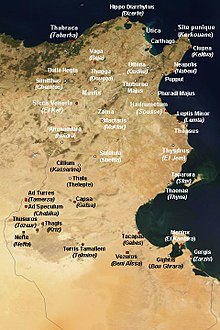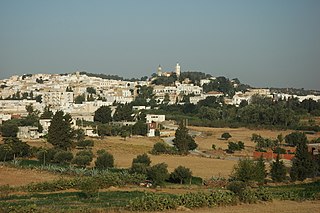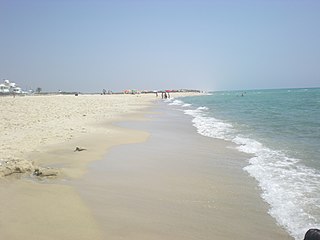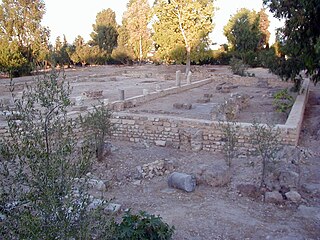
Turris Tamalleni was a town in North Africa, [1] dating from the Carthageinian, Roman, Byzantine and Vandal era. [2] [3]

Turris Tamalleni was a town in North Africa, [1] dating from the Carthageinian, Roman, Byzantine and Vandal era. [2] [3]
The town was west of Tacapes and South of Capsa. [4] [5] [6] It is located on the oasis of Mansura, 1.5 kilometers from Telmine and 7.5 kilometers from Kebili.
Turris Tamalleni town was founded before Carthage, when the Nybgenii Tribe established a fortified granary and a fortified residence for the tribal head. [7] It was renamed in the 1st century C. Civitas Nybgenorium, and remained the center of the Nybgenii Tribe [8] and the name Turres being probably the indigenous name. [9] It was originally a fort on the Roman Limes, [10] and linked by Roman Road under Domitian. [11] Later it became a municipium under Hadrian(about 105AD) taking the name Turris Tamalleni. [12] It is mentioned in the Antonine Itinerary on the road on the borders of Tripoli and Leptis Magna. [13] During the latter Roman era it was a Bishop's seat and a center of resistance of the Almoravids. The city was taken and destroyed by the Almohads in 1205AD. [14] An Arab town called Torrah or telmin was built from the rubble of the Roman town and is identified as runs at ruins of Oum-Es-Samâa. Today, nothing remains of the ancient city. All that remains of the ancient town is two large irrigation basins separated by a wall, which were restored in 1780 by the Bey of Tunis, they form a lake of one hectare. [15]
The Bishopric founded in the fourth century ceased to function with the arrival of the Arab forces, but remains a titular see of the Roman Catholic Church. [16] The current titular bishop is Linus Lee Seong-hyo, auxiliary bishop of Suwon.

Oea was an ancient city in present-day Tripoli, Libya. It was founded by the Phoenicians in the 7th century BC and later became a Roman–Berber colony. As part of the Roman Africa Nova province, Oea and surrounding Tripolitania were prosperous. It reached its height in the 2nd and 3rd centuries AD, when the city experienced a golden age under the Severan dynasty in nearby Leptis Magna. The city was conquered by the Rashidun Caliphate with the spread of Islam in the 7th century and came to be known as Tripoli during the 9th century.

Gafsa, originally called Capsa in Latin, is the capital of Gafsa Governorate of Tunisia. It lends its Latin name to the Mesolithic Capsian culture. With a population of 111,170, Gafsa is the ninth-largest Tunisian city and it is 335 kilometers from the capital Tunis.

Zaghwan is a town in the northern half of Tunisia.
Kelibia (Kélibia), often referred to as Klibia or Gallipia by European writers, is a coastal town on the Cap Bon peninsula, Nabeul Governorate in the far north-eastern part of Tunisia. Its sand beaches are considered some of the finest in the Mediterranean.
The Primate of Africa is an honorific title in the Roman Catholic church, but in early Christianity was the leading bishop (primas) in Africa except for Mauretania which was under the bishop of Rome and Egypt which was suffragan to Alexandria.

Korba, ancient Curubis, is a town in Tunisia on the eastern shore of the Cap Bon. It was the place of exile of the Carthaginian bishop Cyprian in the year leading up to his martyrdom. Modern Korba is in the Nabeul Governorate and had a population of 48,314 in 2014.

Kasserine is the capital city of the Kasserine Governorate, in west-central Tunisia. It is situated below Jebel ech Chambi, Tunisia's highest mountain. Its population is 114.463 (2020).

Téboursouk is a town and commune in the Béja Governorate, Tunisia. It is located at 36° 27′ 26″N, 009° 14′ 54″E.

Pupput, also spelled "Putput", "Pudput", "Pulpud" and "Pulpite" in Latin, sometimes located in Souk el-Obiod ou Souk el-Abiod, is a Colonia in the Roman province of Africa which has been equated with an archaeological site in modern Tunisia. It is situated on the coast near the town of Hammamet, between the two wadis of Temad to the north and Moussa to the south. Much of the Pupput is buried under modern holiday developments which have been built over the major part of the site.

The Archdiocese of Carthage, also known as the Church of Carthage, was a Latin Catholic diocese established in Carthage, Roman Empire, in the 2nd century. Agrippin was the first named bishop, around 230 AD. The temporal importance of the city of Carthage in the Roman Empire had previously been restored by Julius Caesar and Augustus. When Christianity became firmly established around the Roman province of Africa Proconsulare, Carthage became its natural ecclesiastical seat. Carthage subsequently exercised informal primacy as an archdiocese, being the most important center of Christianity in the whole of Roman Africa, corresponding to most of today's Mediterranean coast and inland of Northern Africa. As such, it enjoyed honorary title of patriarch as well as primate of Africa: Pope Leo I confirmed the primacy of the bishop of Carthage in 446: "Indeed, after the Roman Bishop, the leading Bishop and metropolitan for all Africa is the Bishop of Carthage."

Turrisblanda, was a Roman and Byzantine era colonia (town) in the Roman Empire province of Byzacena in what is today modern Tunisia. Its exact location remains unknown. It was also a capital of an historic diocese of the Roman Empire. The bishopric remains today as a titular see of the Roman Catholic Church. The current bishop is Jan Szkodoń, Auxiliary Bishop of Cracow.

Vallitanus or Vallis was an ancient Roman–Berber colonia in Carthage, Tunisia. The town is identified with ruins at Sidi Medien, where are located the remains of a Roman theatre, and a number of Roman inscriptions bearing witness to the town's name, and some local officials of the time can be found near the theatre.

Villamagna of Tripolitania was a Roman era settlement in what was the Roman province of Tripolitania. The town is identifiable with ruins at Henchir-Sidi-Abdein in today's Libya.

Aeliae or Æliæ was a Roman-era city in the province of Byzacena.

Auzegera was a Roman-Berber town in the province of Africa Proconsularis and in late antiquity Byzacena. It was a Catholic Church diocese.
Primian (Primianus) was an early Christian Bishop of Carthage, and leader of the Donatist movement in Roman North Africa. Seen as a moderate by some in his faction, he was a controversial figure in a time of fragmentation of the Donatists, a reactionary branch of Christianity.

Turuzi was an ancient city situated in the Roman province of Africa Proconsularis. Its exact location is now lost to history, but it was somewhere in northern Tunisia.

Muzuca was a Roman Town of the Roman province of Byzacena during late antiquity. The town has tentatively been identified with the ruins at Henchir-Besra in modern Tunisia. Very little is known of the city, though in situ epigraphical evidence gives us the name and that in late antiquity it achieved the status of Municipium.

Marazanae was a Roman town of the Roman province of Byzacena during the Roman Empire and into late antiquity.
The Diocese of Vittoriana is a suppressed and titular see of the Roman Catholic Church.